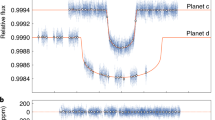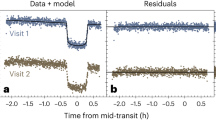Abstract
The giant planet orbiting τ Boötis (named τ Boötis b) was amongst the first extrasolar planets to be discovered1. It is one of the brightest exoplanets and one of the nearest to us, with an orbital period of just a few days. Over the course of more than a decade, measurements of its orbital inclination have been announced2 and refuted3, and have hitherto remained elusive4,5,6,7,8. Here we report the detection of carbon monoxide absorption in the thermal dayside spectrum of τ Boötis b. At a spectral resolution of ∼100,000, we trace the change in the radial velocity of the planet over a large range in phase, determining an orbital inclination of 44.5° ± 1.5° and a mass 5.95 ± 0.28 times that of Jupiter, demonstrating that atmospheric characterization is possible for non-transiting planets. The strong absorption signal points to an atmosphere with a temperature that is decreasing towards higher altitudes, in contrast to the temperature inversion inferred for other highly irradiated planets9,10. This supports the hypothesis that the absorbing compounds believed to cause such atmospheric inversions are destroyed in τ Boötis b by the ultraviolet emission from the active host star11.
This is a preview of subscription content, access via your institution
Access options
Subscribe to this journal
Receive 51 print issues and online access
$199.00 per year
only $3.90 per issue
Buy this article
- Purchase on Springer Link
- Instant access to full article PDF
Prices may be subject to local taxes which are calculated during checkout



Similar content being viewed by others
References
Butler, R. P., Marcy, G. W., Williams, E., Hauser, H. & Shirts, P. Three new “51-Pegasi-type” planets. Astrophys. J. 474, L115–L118 (1997)
Collier Cameron, A., Horne, K., Penny, A. & James, D. Probable detection of starlight reflected from the giant planet orbiting τ Boötis. Nature 402, 751–755 (1999)
Collier Cameron, A., Horne, K., James, D., Penny, A. & Semel, M. in Proceedings of IAU Symposium 202: Planetary Systems in the Universe (eds Penny, A. J., Artymowicz, P., Lagrange, A.-M. & Russell, S. ) 75–77 (Astronomical Society of the Pacific, 2004)
Leigh, C., Collier Cameron, A., Horne, K., Penny, A. & James, D. A new upper limit on the reflected starlight from τ Bootis b. Mon. Not. R. Astron. Soc. 344, 1271–1282 (2003)
Charbonneau, D., Noyes, R. W., Korzennik, S. G., Nienson, P. & Jha, S. An upper limit on the reflected light from the planet orbiting the star τ Bootis. Astrophys. J. 522, L145–L148 (1999)
Wiedemann, G., Deming, D. & Bjoraker, G. A sensitive search for methane in the infrared spectrum of τ Bootis. Astrophys. J. 546, 1068–1074 (2001)
Lucas, P. W. et al. Planetpol polarimetry of the exoplanet systems 55 Cnc and τ Boo. Mon. Not. R. Astron. Soc. 393, 229–244 (2009)
Rodler, F., Kürster, M. & Henning, T. τ Boötis b: hunting for reflected starlight. Astron. Astrophys. 514, A23 (2010)
Burrows, A., Budaj, J. & Hubeny, I. Theoretical spectra and light curves of close-in extrasolar giant planets and comparison with data. Astrophys. J. 678, 1436–1457 (2008)
Fortney, J. J., Lodders, K., Marley, M. S. & Freedman, R. S. A unified theory for the atmospheres of the hot and very hot Jupiters: two classes of irradiated atmospheres. Astrophys. J. 678, 1419–1435 (2008)
Knutson, H. A., Howard, A. W. & Isaacson, H. A correlation between stellar activity and hot-Jupiter emission spectra. Astrophys. J. 720, 1569–1576 (2010)
Kaeufl, H. U. et al. CRIRES: a high resolution infrared spectrograph for ESO’s VLT. Proc. SPIE 5492, 1218–1227 (2004)
Snellen, I. A., de Kok, R. J., de Mooij, E. J. W. & Albrecht, S. The orbital motion, absolute mass and high-altitude winds of exoplanet HD 209458b. Nature 465, 1049–1051 (2010)
Donati, J.-F. et al. Magnetic cycles of the planet-hosting star τ Bootis. Mon. Not. R. Astron. Soc. 385, 1179–1185 (2008)
Takeda, G. et al. Structure and evolution of nearby stars with planets. II. Physical properties of ∼1000 cool stars from the SPOCS catalog. Astrophys. J. Suppl. Ser. 168, 297–318 (2007)
Butler, R. P. et al. Catalog of nearby exoplanets. Astrophys. J. 646, 505–522 (2006)
Catala, C., Donati, J.-F., Shkolnik, E., Bohlender, D. & Alecian, E. The magnetic field of the planet-hosting star τ Bootis. Mon. Not. R. Astron. Soc. 374, L42–L46 (2007)
Winn, J. N., Fabrycky, D., Albrecht, S. & Johnson, J. A. Hot stars with hot Jupiters have high obliquities. Astrophys. J. 718, L145–L149 (2010)
Johnson, J. A. et al. HAT-P-30b: a transiting hot Jupiter on a highly oblique orbit. Astrophys. J. 735, 24–31 (2011)
Hébrard, G. et al. Observation of the full 12-hour-long transit of the exoplanet HD 80606b. Warm-Spitzer photometry and SOPHIE spectroscopy. Astron. Astrophys. 516, A95 (2010)
Schneider, J., Dedieu, C., Le Sinader, P., Savalle, R. & Zolotukhin, I. Defining and cataloguing exoplanets: the exoplanet.eu database. Astron. Astrophys. 532, A79 (2011)
Knutson, H. A., Charbonneau, D., Burrows, A., O'Donovan, F. T. & Mandushev, G. Detection of a temperature inversion in the broadband infrared emission spectrum of TrES-4. Astrophys. J. 691, 866–874 (2009)
Acknowledgements
We thank the ESO support staff of the Paranal Observatory for their help during the observations. This work is based on observations collected at the European Southern Observatory (186.C-0289). S.A. acknowledges support by a Rubicon fellowship from the Netherlands Organisation for Scientific Research (NWO), and by NSF grant no. 1108595.
Author information
Authors and Affiliations
Contributions
M.B. led the observations and data analysis, and co-wrote the manuscript. I.A.G.S. conceived the project, contributed to the analysis and co-wrote the manuscript. R.J.d.K. constructed the planet atmosphere models. S.A. conducted the MCMC orbital analysis. J.B., E.J.W.d.M., R.J.d.K. and S.A. discussed the analyses, results and commented on the manuscript.
Corresponding author
Ethics declarations
Competing interests
The authors declare no competing financial interests.
Supplementary information
Supplementary Information
This file contains Supplementary Text, Supplementary Figures 1-9 and additional references. (PDF 1534 kb)
Rights and permissions
About this article
Cite this article
Brogi, M., Snellen, I., de Kok, R. et al. The signature of orbital motion from the dayside of the planet τ Boötis b. Nature 486, 502–504 (2012). https://doi.org/10.1038/nature11161
Received:
Accepted:
Published:
Issue Date:
DOI: https://doi.org/10.1038/nature11161
This article is cited by
-
On the synergy between Ariel and ground-based high-resolution spectroscopy
Experimental Astronomy (2022)
-
Determination of stellar parameters for Ariel targets: a comparison analysis between different spectroscopic methods
Experimental Astronomy (2022)
-
Titanium oxide and chemical inhomogeneity in the atmosphere of the exoplanet WASP-189 b
Nature Astronomy (2022)
-
A solar C/O and sub-solar metallicity in a hot Jupiter atmosphere
Nature (2021)
-
Exoplanet spectroscopy and photometry with the Twinkle space telescope
Experimental Astronomy (2019)
Comments
By submitting a comment you agree to abide by our Terms and Community Guidelines. If you find something abusive or that does not comply with our terms or guidelines please flag it as inappropriate.



